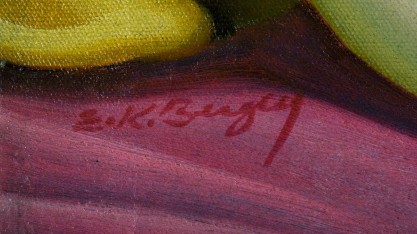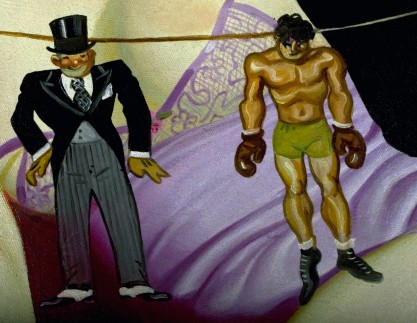


Created for the October, 1935 issue of the spicy pulp title La Paree, this is a rare surviving original cover painting by Earle K. Bergey. In this whimsical jazz-age art deco scene, a blonde flapper girl is attempting to choose who will get to play the part of her dream man. Vying for the title are a number of suitors– a World War I veteran, a young sailor, a prize fighting boxer and a top hatted dandy representing the many “types” of red-blooded American men. Bergey frequently explored the theme of men as women’s play things, depicting them as marionettes, cut out silhouettes, and, as seen here, paper dolls dangling from a string. For publication, La Paree inverted the image 180 degrees, for spacing purposes for the top title text placement. This is from the collection of the legendary Sire Records founder and A & R man Seymour Stein, who had the smarts to sign Madonna to her first record contract in 1983, but also the stones to sign both The Ramones and The Replacements.



A bio on the artist courtesy of David Saunders :
“Earle” Bergey was born Earl Kulp Bergey on August 26, 1901 in Philadelphia, PA. His father was A. Frank Bergey and his mother was Ella Kulp Bergey. There were six children in the family. Earl was the fifth born. They lived at 2344 Twelfth Street. His father was a musical band director, as well as a musician.
He finished high school in 1919, but he was too young to serve in World War I. He began to work as an artist for a Philadelphia newspaper publisher. He lived with his mother and two siblings at 4312 Eighth Street, while his father lived separately at 1115 West Dauphin Street.
From 1921 to 1926 he attended night classes at the Pennsylvania Academy of Fine Arts. However, he is not listed as having ever been a full-time art student or having graduated the school.
He continued his work for newspapers and by 1927 he was drawing a comic strip called Deb Days for The Philadelphia Ledger.
His father died in 1928. With his father’s life insurance his mother was able to buy a home for fifteen thousand dollars at 468 Township Line in Horsham, PA, Montgomery County, where there was room for him and three siblings and a brother-in-law.
In 1934 he married his wife, Elizabeth Bergey, and in 1935 they moved to Doylestown, PA, in Bucks County, to raise a family. They had three children, Earle & Joanne, who were twins, and John. It was a pleasure to have his own home, because at age thirty-five he was finally able to work in his own private art studio space.
During the Great Depression newspaper circulations shrank as advertising fell off. At the same time many illustrators were finding new opportunities in the New York City pulp magazine industry, which had begun to enter their most prosperous years. His first pulp magazine covers were for the spicy pin-up titles, such as Gay Book, Pep, La Paree, Bedtime, Snappy, and Brief Stories.
He then sold freelance pulp covers to the Thrilling Group publications, which was owned by Ned Pines, such as Captain Future, Exciting Football, Startling Stories, Thrilling Sports, and Thrilling Wonder.
Nothing is known of his military service during World War II, but on November 27, 1945 a Staff Sergeant in the Army Corps of Engineers, named Earle Bergey of Pennsylvania and aged forty-five, is recorded to have sailed on the Queen Mary with thousands of returning troops from England to New York City.
By 1948 the owner of the Thrilling Group, Ned Pines, was producing Popular Library paperback books. Many of these covers were assigned to Earle Bergey. Bergey was a friend of the art editor, Churchill Ettinger, a former illustrator for the New York Sunday World. In addition, Bergey was also pals with another pulp illustrator from Pennsylvania, Rudy Belarski. The three friends would frequently get together for lunch and discuss ideas for paperback book covers, while creating the influential look of Popular Library paperbacks from 1948 to 1952. Bergey’s most notable contribution to this heritage was Gentlemen Prefer Blondes.
Besides Popular Library, he also illustrated paperback book covers for other publishers, such as Avon Books, Lion Books, and Pocket Books.
Earle Bergey died unexpectedly while undergoing a stress test on his heart in a doctor’s office at age fifty-one on September 30, 1952.

